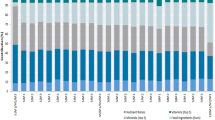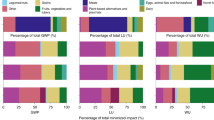Abstract
Objective:
Recent studies support the hypothesis that plant-based diets are environmentally better than meat-based diets. This study aims to further explore this topic and to compare different environmental impacts resulting from different dietary patterns (omnivorous, vegetarian, vegan) and methods of production (conventional farming and organic agriculture).
Design:
Three weekly balanced diets, equivalent to one another for energetic and nutrient content, have been planned: an omnivorous one, a vegetarian one and a vegan one. For each one, the Life Cycle Assessment (LCA) method has been applied in order to calculate the environmental impact, expressed in ‘points’.
Interventions:
The software we selected to carry out the Inventory Analysis and the Impact Assessment is SimaPro5. The Assessment phase has been conducted using Ecoindicator 99, a damage-oriented method, which analyses the impact according to three large damage categories, each of them subsuming various impact categories.
This is a preview of subscription content, access via your institution
Access options
Subscribe to this journal
Receive 12 print issues and online access
$259.00 per year
only $21.58 per issue
Buy this article
- Purchase on Springer Link
- Instant access to full article PDF
Prices may be subject to local taxes which are calculated during checkout

Similar content being viewed by others
References
Aghina C, Maletto S (1979). Tecnica Mangimistica (Feeding technique) Ed. Esculapio (in Italian) Bologna: Italy.
ANPA (2000). I rifiuti del comparto agricolo (Agricultural wastes) RTI CTN_RIF (in Italian), Italy.
Baldoni R, Giardini L (2002). Coltivazioni Erbacee: Foraggiere e Tappeti Erbosi (Herbaceous cultivations: fodder and grass) Pàtron Editore (in Italian) Bologna: Italy.
Baldoni R, Giardini L (2002a). Coltivazioni Erbacee: Cereali e Proteaginose (Herbaceous cultivations: cereals and oleaginous) Pàtron Editore (in Italian) Bologna: Italy.
Baldoni R, Giardini L (2002b). Coltivazioni Erbacee: Piante oleifere da zucchero, da fibra, orticole e aromatiche (Herbaceous cultivations: sugar roots, starchy vegetables, vegetables, aromatic plants) Pàtron Editore (in Italian) Bologna: Italy.
Barnard ND (1994). Food for Life: How the New Four Food Groups Can Save Your Life. Crown Pub.
Beeton R (2003). Sustainably managing food production resources to maximise human nutritional benefit. Asia Pac J Clin Nutr 12 (Suppl), S50.
Cederberg C (1998). Life Cycle Assessment of Milk Production SIK-Report No. 643, SIK. The Swedish Institute for Food and Biotechnology: Sweden.
Conso P (1992). Alimentazione ed alimenti per il bestiame (Feeding and feed for farm animals) Ed. Edagricole (in Italian) Bologna: Italy.
CORINAIR (1996). The EMEP/CORINAIR Atmospheric Emission Inventory Guidebook. European Environment Agency: Denmark.
Cowell SJ, Fairman R, Lofstedt RE (2002). Use of risk assessment and life cycle assessment in decision making: a common policy research agenda. Risk Anal 22, 879–894.
Denslow J, Padoch C (1988). People of the Tropical Rainforest. University of California Press: Berkeley. p. 169.
Ekvall T, Weidema BP (2004). System Boundaries and Input Data in Consequential Life Cycle Inventory Analysis. Int J Life Cycle Assess 9 (3), 161–171.
Environmental management – Life Cycle Assessment (1997–2000). ISO series 14040. International Organization Standardization.
Euromeat (2001): http://www.pubit.it/sunti/euc0106l.html(Accessed 12 June 2004).
Eurostat (2000): http://www.cso.ie/releasespublications/documents/agriculture/current/meatsup.pdf(Accessed 20 June 2004).
FAO (2001). Food Balance Sheet. http://apps.fao.org/(Accessed 11 May 2004).
Fox MA (1999). The contribution of vegetarianism to ecosystem health. Ecosyst Health 5, 70–74.
Frees N (1998). Life Cycle Assessment on Packaging System for Beer and Soft drinks Technical Report No. 7: Energy and Transport Scenarios, Chalmers Industrial Technology, Sweden and Institute for Product Development: Denmark.
Fukuoka M (2001). La Fattoria Biologica: agricoltura secondo natura (Organic farming: natural agriculture) Ed. Mediterranee (in Italian) Roma: Italy.
Goedkoop M, Oele M. (2001). Introduction into LCA Methodology and Practice with SimaPro 5. PRé Consultants: Amersfoort. pp 55.
Goedkoop M, Spriensma R (2000). The Eco-Indicator 99, A Damage Oriented Method for Life Cycle Assessment Methodology Report, 2nd edn. PRé Consultants: Amersfoort, pp 55.
Gussow JD (1978). The Feeding Web: Issues in Nutriotional Ecology. Bull Publishing Co. Inc.: Palo Alto, CA.
Gussow JD (1994). Ecology and vegetarian consideration: does environmental responsibility demand the elimination of livestock? Am J Clin Nutr 59 (Suppl), 1110S–1116S.
Høgass Eide M., Ohlsson T (1998). A comparison of two different approaches to inventory analysis of diaries. Int J LCA 3, 209–215.
Høgass Eide M (2002). Life Cycle Assessment (LCA) of industrial milk production. Int J Life Cycle Assess 7, 115–126.
Imhoff ML, Bounoua L, Ricketts T, Loucks C, Harriss R, Lawrence WT (2004). Global patterns in human consumption of net primary production. Nature 429, 870–873.
Kaimowitz D, Mertens B, Wunder S, Pacheco P (2003). Hamburger Connection Fuels Amazon Destruction. Center for International Forestry Research (CIFOR), April.
Leitzmann C (2003). Nutrition ecology: the contribution of vegetarian diets. Am J Clin Nutr 78 (Suppl), 657S–659S.
Matthews HS, Lave L, MacLean H (2002). Life cycle impact assessment: a challenge for risk analysts. Risk Anal 22, 853–860.
Mattoni L (2000). Ottimizzazione della gestione integrata dei rifiuti solidi urbani ed assimilabili, ENEA. National Institute for Energy and Environment. (in Italian) Roma: Italy.
Moriconi E (1997). Nutrirsi tutti, inquinando meno (Food for everyone, with less pollution). Regione Piemonte, Assessorato Tutela Ambientale. (in Italian).
Moriconi E (2001). Le fabbriche degli animali: ‘mucca pazza’ e dintorni (Animal factories: ‘mad cow’ and neighbouring). Ed. Cosmopolis: Torino. (in Italian).
Pimentel D, Bailey O, Kim P, Mullaney E, Calabrese J, Walman L et al. (1999). Will limits of the earth's resources control human numbers? Environ Dev Sustain 1, 19–39.
Pimentel D, Houser J, Preiss E, White O, Fang H, Mesnick L et al. (1997). Water resources: agriculture, the environment, and society – an assessment of the status of water resources. Bioscience 47 (2), 97–106.
Pimentel D, Pimentel M (1993). World population, food, natural resources and survival. World Futures 59, 145–167.
Pimentel D, Pimentel M (1999). Population growth, environmental resources and global food. J Sustain Forests 9, 35–44.
Pimentel D, Pimentel M (2000). To improve nutrition for the world's population. Science 288, 1966–1967.
Pimentel D, Pimentel M (2003). Sustainability of meat-based and plant-based diets and the environment. Am J Clin Nutr 78 (Suppl), 660S–663S.
Rebitzer G, Ekvall T, Frischknecht R, Hunkeler D, Norris G, Rydberg T et al. (2004). Life cycle assessment: framework, goal and scope definition, inventory analysis, and applications. Environ Int 30, 701–720.
Reijnders L, Soret S (2003). Quantification of the environmental impact of different dietary protein choices. Am J Clin Nutr 78 (Suppl), 664S–668S.
Renault D, Wallender WW (2000). Nutritional Water Productivity and Diets. Agric Water Manage 45, 275–296.
Rojstaczer S, Sterling SM, Moore NJ (2001). Human appropriation of photosynthesis products. Science 294, 2549–2552.
Spitzmüller E-M, Schönfelder-Pflug K, Leitzmann C (1993). Ernährungsökologie: Essen zwischen Genuss und Verantwortung. (Nutrition ecology: eating between relish and responsibility). Haug: Heidelberg, Germany. (in German).
UN Department of Economic and Social Affairs, Division for Sustainable Development (2004). Indicators of Sustainable Development: Framework and Methodologies December.http://www.un.org/esa/sustdev/natlinfo/indicators/indisd/english/chapt12e.htm(accessed March 2005).
Watanabe T (1989). Il libro della soia (The Soy Book) Ed. Mediterranee (in Italian) Roma: Italy.
World Health Organization (1996). Micronutrient malnutrition – half of the world's population affected. World Health Organ 78, 1–4.
World Health Organization (2000). Turning the Tide of Malnutrition: Responding to the challenge of the 21st Century. World Health Organization: Geneva.
World Watch Institute (2004). State of the World 2004 WWI Report.
World Wildlife Fund (1997). The year the world caught fire Report WWF, December.
Acknowledgements
We thank Paul Appleby (Senior Statistician, Cancer Epidemiology Unit, University of Oxford, Oxford, UK) for his expert suggestions on the drafts of this paper and Raffaella Ravasso (ATRA Documentation Center, Lugano, Switzerland) for her analytic assistance. None of the authors had any conflict of interest.
Author information
Authors and Affiliations
Corresponding author
Additional information
Guarantor: M Tettamanti.
Contributors: MT set up the study and with the aid of MB, analysed the data and wrote the paper. LC set up the meal planning and LB provided significant consultation and helped in the writing and reviewing of the paper.
Rights and permissions
About this article
Cite this article
Baroni, L., Cenci, L., Tettamanti, M. et al. Evaluating the environmental impact of various dietary patterns combined with different food production systems. Eur J Clin Nutr 61, 279–286 (2007). https://doi.org/10.1038/sj.ejcn.1602522
Received:
Revised:
Accepted:
Published:
Issue Date:
DOI: https://doi.org/10.1038/sj.ejcn.1602522
Keywords
This article is cited by
-
Carbon Emission Effects Driven by Evolution of Chinese Dietary Structure from 1987 to 2020
Chinese Geographical Science (2024)
-
Assessment of the level of some selected heavy metals and physicochemical in Abzana water samples, Kibet woreda, Ethiopia
International Journal of Environmental Science and Technology (2023)
-
The carbon footprint of common vegetarian and non-vegetarian meals in Portugal: an estimate, comparison, and analysis
The International Journal of Life Cycle Assessment (2023)
-
Default Vegetarianism and Veganism
Journal of Agricultural and Environmental Ethics (2021)



